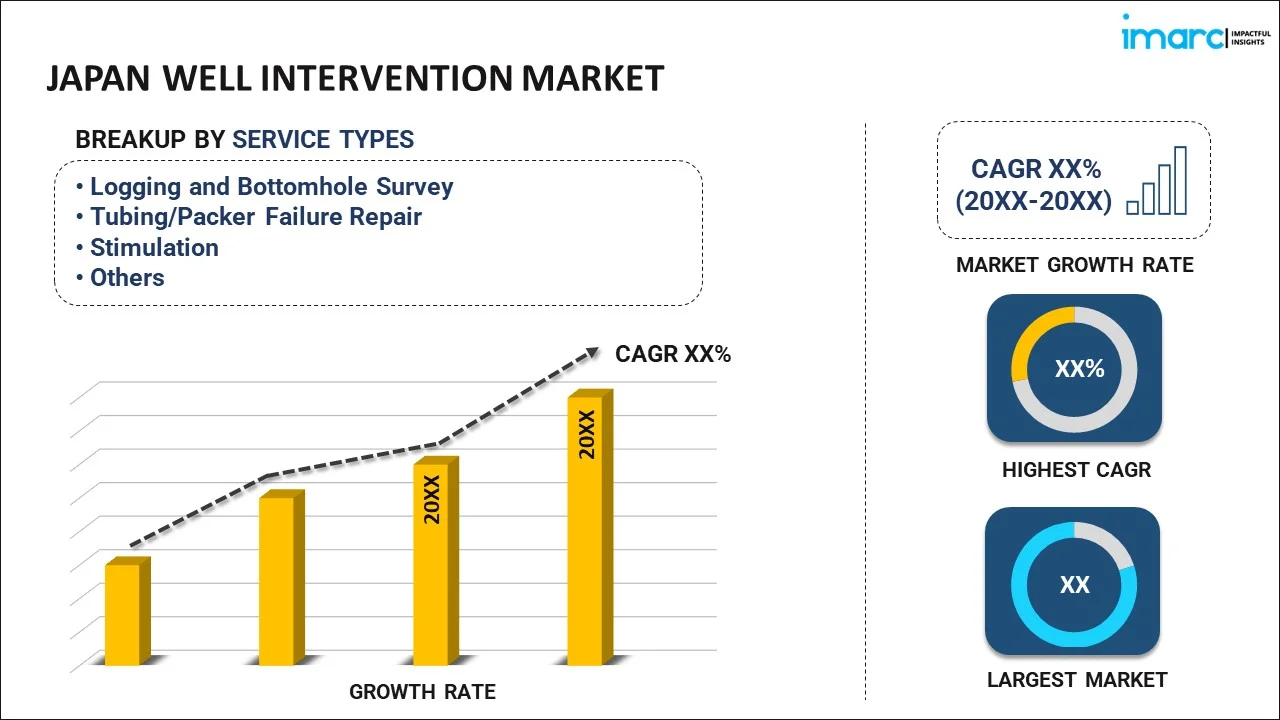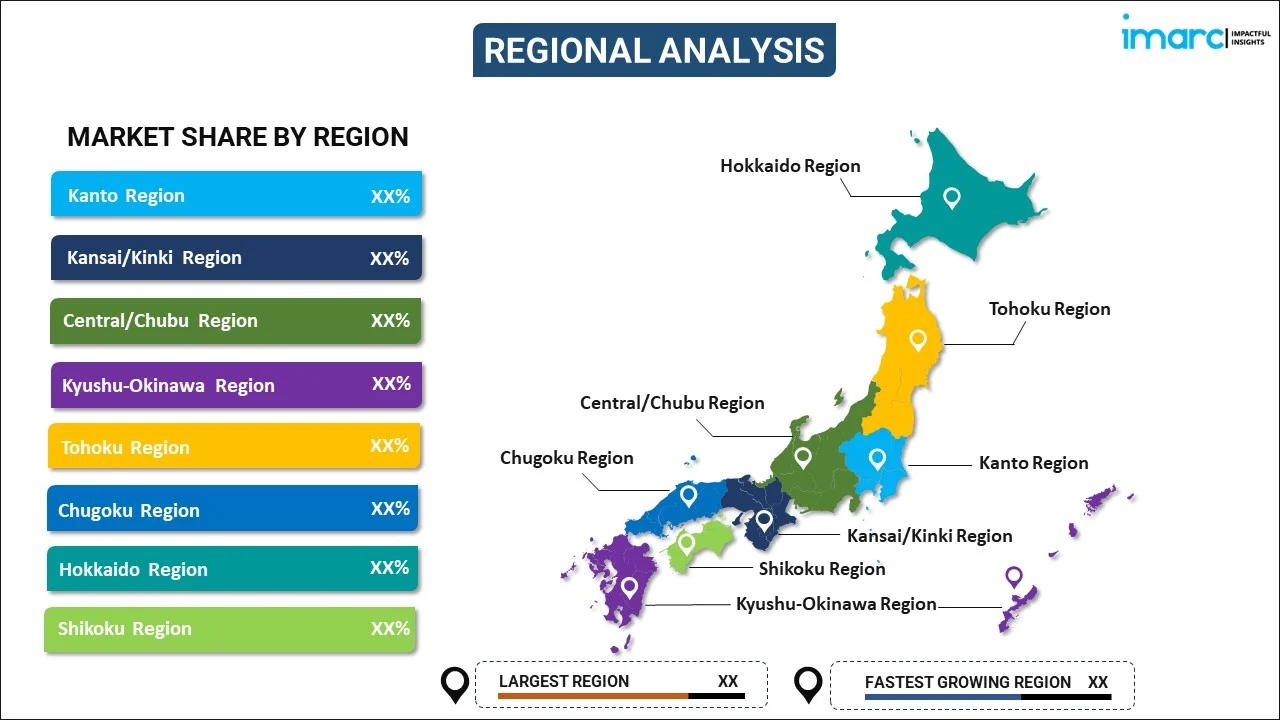
Japan Well Intervention Market Report by Service Type (Logging and Bottomhole Survey, Tubing/Packer Failure Repair, Stimulation, Sand Control, Zonal Isolation, Artificial Lift, Fishing, and Others), Well Type (Vertical Well, Horizontal Well), Application (Onshore, Offshore), and Region 2025-2033
Market Overview:
Japan well intervention market size reached USD 506.3 Million in 2024. Looking forward, IMARC Group expects the market to reach USD 776.0 Million by 2033, exhibiting a growth rate (CAGR) of 4.50% during 2025-2033. A significant shift toward cleaner and renewable energy sources, aging oil and gas infrastructure across the country, ongoing advancements in well intervention techniques, and stringent environmental regulations represent some of the key factors driving the market.
|
Report Attribute
|
Key Statistics
|
|---|---|
|
Base Year
|
2024 |
|
Forecast Years
|
2025-2033
|
|
Historical Years
|
2019-2024
|
| Market Size in 2024 | USD 506.3 Million |
| Market Forecast in 2033 | USD 776.0 Million |
| Market Growth Rate (2025-2033) | 4.50% |
Well intervention is the process of conducting operations on an existing oil or gas well to extend its life, enhance its performance, and fix issues. These wells often encounter challenges like reduced flow rates or mechanical complications. Through well intervention, operators can actively diagnose, manage, and rectify such issues to maintain optimal production levels. Various methods, including coiled tubing, wireline, and hydraulic workover units, are employed to carry out specific tasks like well cleaning, artificial lift, and perforation. Well intervention can be categorized into light, medium, and heavy interventions based on the complexity and scale of operations. Light interventions often involve simpler tasks like wellbore diagnostics, while medium interventions may require the use of pressure control equipment. On the other hand, heavy interventions usually entail pulling the existing completion and replacing it with a new one. The importance of well intervention cannot be overstated, as it directly impacts the profitability and sustainability of oil and gas operations. With the energy industry focusing increasingly on maximizing the efficiency of existing assets due to environmental considerations, well intervention techniques are evolving to become more advanced and less intrusive, aiming to minimize the environmental footprint while maximizing well performance. As a result, well intervention has gained immense traction as a critical element in the maintenance and life-cycle management of hydrocarbon reservoirs across Japan and the world.
Japan Well Intervention Market Trends:
The Japan well intervention market is primarily driven by several key factors that reflect the country’s unique energy landscape and industry dynamics. In recent years, Japan’s energy mix has been undergoing a significant transformation. The country, in its pursuit of energy security and sustainability, is increasingly turning to natural gas and renewable energy sources. This shift has created opportunities for well intervention services in the maintenance and optimization of gas wells, particularly those involved in liquefied natural gas (LNG) production, contributing to market growth. Additionally, the aging infrastructure of Japan’s oil and gas fields represents another major growth-inducing factor. Many of the country’s wells are mature and require ongoing maintenance and optimization to sustain production levels, thus fueling the demand for well intervention services, such as well stimulation, hydraulic fracturing, and wellbore cleaning, to enhance well performance. Furthermore, Japan’s commitment to environmental stewardship and stringent regulations have prompted operators to adopt cleaner and more efficient practices. Well intervention services are instrumental in minimizing fugitive emissions, reducing environmental impacts, and ensuring compliance with environmental regulations, which in turn is accelerating the product adoption rate. Moreover, the country’s strategic location in the Asia-Pacific region positions it as a major hub for energy trade. The country’s demand for well intervention services is not limited to its domestic operations but also extends to international projects. This global reach is offering lucrative opportunities for well intervention companies to expand their footprint in the Asia-Pacific region, thereby propelling market growth.
Japan Well Intervention Market Segmentation:
IMARC Group provides an analysis of the key trends in each segment of the market, along with forecasts at the country level for 2025-2033. Our report has categorized the market based on service type, well type, and application.
Service Type Insights:

- Logging and Bottomhole Survey
- Tubing/Packer Failure Repair
- Stimulation
- Sand Control
- Zonal Isolation
- Artificial Lift
- Fishing
- Others
The report has provided a detailed breakup and analysis of the market based on the service type. This includes logging and bottomhole survey, tubing/packer failure repair, stimulation, sand control, zonal isolation, artificial lift, fishing, and others.
Well Type Insights:
- Vertical Well
- Horizontal Well
A detailed breakup and analysis of the market based on the well type have also been provided in the report. This includes vertical well and horizontal well.
Application Insights:
- Onshore
- Offshore
The report has provided a detailed breakup and analysis of the market based on the application. This includes onshore and offshore.
Regional Insights:

- Kanto Region
- Kansai/Kinki Region
- Central/ Chubu Region
- Kyushu-Okinawa Region
- Tohoku Region
- Chugoku Region
- Hokkaido Region
- Shikoku Region
The report has also provided a comprehensive analysis of all the major regional markets, which include Kanto Region, Kansai/Kinki Region, Central/ Chubu Region, Kyushu-Okinawa Region, Tohoku Region, Chugoku Region, Hokkaido Region, and Shikoku Region.
Competitive Landscape:
The market research report has also provided a comprehensive analysis of the competitive landscape. Competitive analysis such as market structure, key player positioning, top winning strategies, competitive dashboard, and company evaluation quadrant has been covered in the report. Also, detailed profiles of all major companies have been provided.
Japan Well Intervention Market Report Coverage:
| Report Features | Details |
|---|---|
| Base Year of the Analysis | 2024 |
| Historical Period | 2019-2024 |
| Forecast Period | 2025-2033 |
| Units | Million USD |
| Scope of the Report | Exploration of Historical Trends and Market Outlook, Industry Catalysts and Challenges, Segment-Wise Historical and Future Market Assessment:
|
| Service Types Covered | Logging and Bottomhole Survey, Tubing/Packer Failure Repair, Stimulation, Sand Control, Zonal Isolation, Artificial Lift, Fishing, Others |
| Well Types Covered | Vertical Well, Horizontal Well |
| Applications Covered | Onshore, Offshore |
| Regions Covered | Kanto Region, Kansai/Kinki Region, Central/ Chubu Region, Kyushu-Okinawa Region, Tohoku Region, Chugoku Region, Hokkaido Region, Shikoku Region |
| Customization Scope | 10% Free Customization |
| Post-Sale Analyst Support | 10-12 Weeks |
| Delivery Format | PDF and Excel through Email (We can also provide the editable version of the report in PPT/Word format on special request) |
Key Questions Answered in This Report:
- How has the Japan well intervention market performed so far and how will it perform in the coming years?
- What has been the impact of COVID-19 on the Japan well intervention market?
- What is the breakup of the Japan well intervention market on the basis of service type?
- What is the breakup of the Japan well intervention market on the basis of well type?
- What is the breakup of the Japan well intervention market on the basis of application?
- What are the various stages in the value chain of the Japan well intervention market?
- What are the key driving factors and challenges in the Japan well intervention?
- What is the structure of the Japan well intervention market and who are the key players?
- What is the degree of competition in the Japan well intervention market?
Key Benefits for Stakeholders:
- IMARC’s industry report offers a comprehensive quantitative analysis of various market segments, historical and current market trends, market forecasts, and dynamics of the Japan well intervention market from 2019-2033.
- The research report provides the latest information on the market drivers, challenges, and opportunities in the Japan well intervention market.
- Porter's five forces analysis assist stakeholders in assessing the impact of new entrants, competitive rivalry, supplier power, buyer power, and the threat of substitution. It helps stakeholders to analyze the level of competition within the Japan well intervention industry and its attractiveness.
- Competitive landscape allows stakeholders to understand their competitive environment and provides an insight into the current positions of key players in the market.
Need more help?
- Speak to our experienced analysts for insights on the current market scenarios.
- Include additional segments and countries to customize the report as per your requirement.
- Gain an unparalleled competitive advantage in your domain by understanding how to utilize the report and positively impacting your operations and revenue.
- For further assistance, please connect with our analysts.
 Inquire Before Buying
Inquire Before Buying
 Speak to an Analyst
Speak to an Analyst
 Request Brochure
Request Brochure
 Request Customization
Request Customization




.webp)




.webp)












